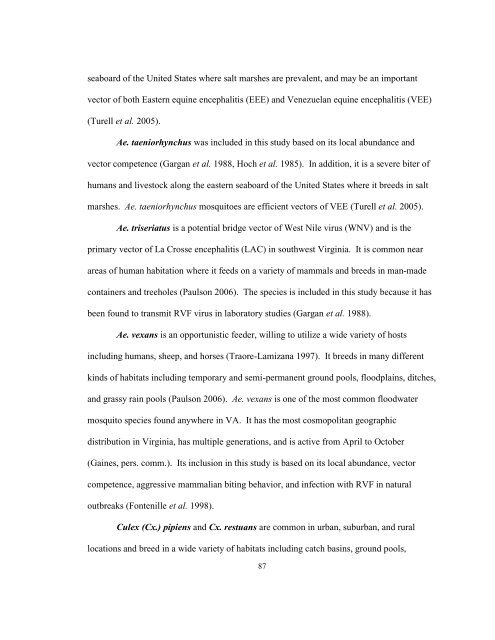Sample A: Cover Page of Thesis, Project, or Dissertation Proposal
Sample A: Cover Page of Thesis, Project, or Dissertation Proposal
Sample A: Cover Page of Thesis, Project, or Dissertation Proposal
Create successful ePaper yourself
Turn your PDF publications into a flip-book with our unique Google optimized e-Paper software.
seaboard <strong>of</strong> the United States where salt marshes are prevalent, and may be an imp<strong>or</strong>tant<br />
vect<strong>or</strong> <strong>of</strong> both Eastern equine encephalitis (EEE) and Venezuelan equine encephalitis (VEE)<br />
(Turell et al. 2005).<br />
Ae. taeni<strong>or</strong>hynchus was included in this study based on its local abundance and<br />
vect<strong>or</strong> competence (Gargan et al. 1988, Hoch et al. 1985). In addition, it is a severe biter <strong>of</strong><br />
humans and livestock along the eastern seaboard <strong>of</strong> the United States where it breeds in salt<br />
marshes. Ae. taeni<strong>or</strong>hynchus mosquitoes are efficient vect<strong>or</strong>s <strong>of</strong> VEE (Turell et al. 2005).<br />
Ae. triseriatus is a potential bridge vect<strong>or</strong> <strong>of</strong> West Nile virus (WNV) and is the<br />
primary vect<strong>or</strong> <strong>of</strong> La Crosse encephalitis (LAC) in southwest Virginia. It is common near<br />
areas <strong>of</strong> human habitation where it feeds on a variety <strong>of</strong> mammals and breeds in man-made<br />
containers and treeholes (Paulson 2006). The species is included in this study because it has<br />
been found to transmit RVF virus in lab<strong>or</strong>at<strong>or</strong>y studies (Gargan et al. 1988).<br />
Ae. vexans is an opp<strong>or</strong>tunistic feeder, willing to utilize a wide variety <strong>of</strong> hosts<br />
including humans, sheep, and h<strong>or</strong>ses (Tra<strong>or</strong>e-Lamizana 1997). It breeds in many different<br />
kinds <strong>of</strong> habitats including temp<strong>or</strong>ary and semi-permanent ground pools, floodplains, ditches,<br />
and grassy rain pools (Paulson 2006). Ae. vexans is one <strong>of</strong> the most common floodwater<br />
mosquito species found anywhere in VA. It has the most cosmopolitan geographic<br />
distribution in Virginia, has multiple generations, and is active from April to October<br />
(Gaines, pers. comm.). Its inclusion in this study is based on its local abundance, vect<strong>or</strong><br />
competence, aggressive mammalian biting behavi<strong>or</strong>, and infection with RVF in natural<br />
outbreaks (Fontenille et al. 1998).<br />
Culex (Cx.) pipiens and Cx. restuans are common in urban, suburban, and rural<br />
locations and breed in a wide variety <strong>of</strong> habitats including catch basins, ground pools,<br />
87




![[Sample B: Approval/Signature Sheet] - George Mason University](https://img.yumpu.com/21978828/1/190x245/sample-b-approval-signature-sheet-george-mason-university.jpg?quality=85)


![[Sample B: Approval/Signature Sheet] - George Mason University](https://img.yumpu.com/18694905/1/190x245/sample-b-approval-signature-sheet-george-mason-university.jpg?quality=85)






![[Sample B: Approval/Signature Sheet] - George Mason University](https://img.yumpu.com/18694552/1/189x260/sample-b-approval-signature-sheet-george-mason-university.jpg?quality=85)


![[Sample B: Approval/Signature Sheet] - George Mason University](https://img.yumpu.com/18694474/1/190x245/sample-b-approval-signature-sheet-george-mason-university.jpg?quality=85)